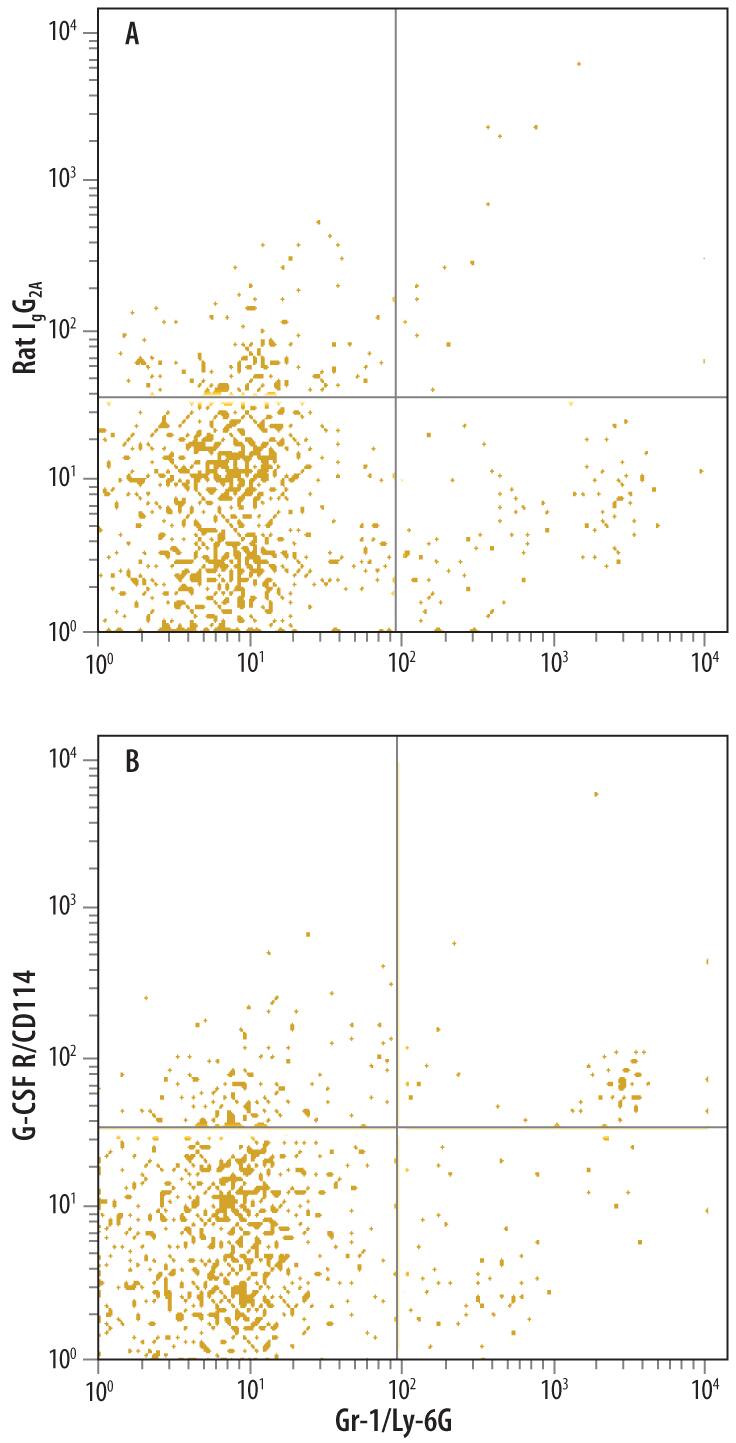Mouse G-CSFR/CD114 Antibody
R&D Systems, part of Bio-Techne | Catalog # MAB60391


Conjugate
Catalog #
Key Product Details
Species Reactivity
Mouse
Applications
CyTOF-ready, Flow Cytometry
Label
Unconjugated
Antibody Source
Monoclonal Rat IgG2A Clone # 723806
Product Specifications
Immunogen
Mouse myeloma cell line NS0-derived recombinant mouse G-CSF R/CD114
Cys26-Asp626
Accession # P40223
Cys26-Asp626
Accession # P40223
Specificity
Detects mouse G-CSF R/CD114 in direct ELISAs. In direct ELISAs, no cross-reactivity with recombinant
mouse (rm) GM-CSF R alpha, rmM-CSF R, recombinant human (rh) G-CSF R alpha, or
rhGM-CSF R beta is observed.
Clonality
Monoclonal
Host
Rat
Isotype
IgG2A
Scientific Data Images for Mouse G-CSFR/CD114 Antibody
Detection of G-CSF R/CD114 in Mouse bone marrow by Flow Cytometry.
Mouse bone marrow cells were stained with Rat Anti-Mouse Gr-1/Ly-6G PE-conjugated Monoclonal Antibody (FAB1037P) and either (A) Rat Anti-Mouse G-CSF R/CD114 Monoclonal Antibody (Catalog # MAB60391) or (B) Rat IgG2A Isotype Control (MAB006) followed by APC-conjugated Anti-Rat IgG Secondary Antibody (F0113). Staining was performed using our Staining Membrane-associated Proteins protocol.Detection of G-CSF R/CD114 in Mouse splenocytes by Flow Cytometry.
Mouse splenocytes were stained with Rat Anti-Mouse Gr-1/Ly-6G APC-conjugated Monoclonal Antibody (Catalog # FAB1037A) and either (A) Rat IgG2A Isotype Control (Catalog # MAB006) or (B) Rat Anti-Mouse G-CSF R/CD114 Monoclonal Antibody (Catalog # MAB60391) followed by Phycoerythrin-conjugated Anti-Rat IgG Secondary Antibody (Catalog # F0105B).Applications for Mouse G-CSFR/CD114 Antibody
Application
Recommended Usage
CyTOF-ready
Ready to be labeled using established conjugation methods. No BSA or other carrier proteins that could interfere with conjugation.
Flow Cytometry
0.25 µg/106 cells
Sample: Mouse bone marrow cells and splenocytes
Sample: Mouse bone marrow cells and splenocytes
Formulation, Preparation, and Storage
Purification
Protein A or G purified from hybridoma culture supernatant
Reconstitution
Sterile PBS to a final concentration of 0.5 mg/mL. For liquid material, refer to CoA for concentration.
Formulation
Lyophilized from a 0.2 μm filtered solution in PBS with Trehalose. *Small pack size (SP) is supplied either lyophilized or as a 0.2 µm filtered solution in PBS.
Shipping
Lyophilized product is shipped at ambient temperature. Liquid small pack size (-SP) is shipped with polar packs. Upon receipt, store immediately at the temperature recommended below.
Stability & Storage
Use a manual defrost freezer and avoid repeated freeze-thaw cycles.
- 12 months from date of receipt, -20 to -70 °C as supplied.
- 1 month, 2 to 8 °C under sterile conditions after reconstitution.
- 6 months, -20 to -70 °C under sterile conditions after reconstitution.
Background: G-CSFR/CD114
References
- Ward, A.C. (2007) Front. Biosci. 12:608.
- Layton, J.E. and N.E. Hall (2006) Front. Biosci. 11:3181.
- Mitsui, T. et al. (2003) Blood 101:2990.
- Nicola, N.A. in Cytokine Reference, 2001, Oppenheim, J.J. and M. Feldmann, eds. Academic Press p.1935.
Long Name
Granulocyte Colony Stimulating Factor Receptor
Alternate Names
CD114, CSF3R, Csfgr, G-CSF R, GCSFR
Gene Symbol
CSF3R
UniProt
Additional G-CSFR/CD114 Products
Product Documents for Mouse G-CSFR/CD114 Antibody
Product Specific Notices for Mouse G-CSFR/CD114 Antibody
For research use only
